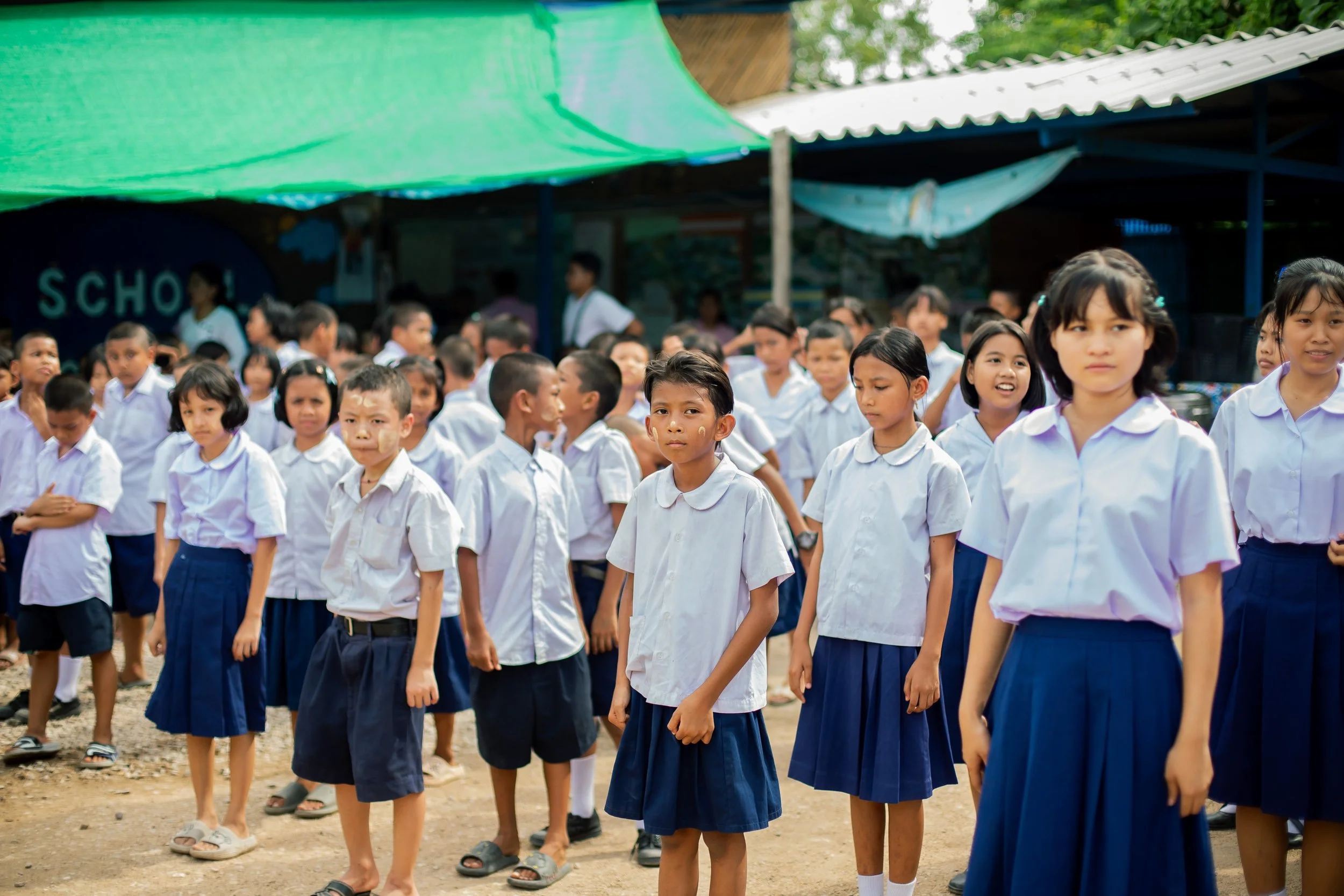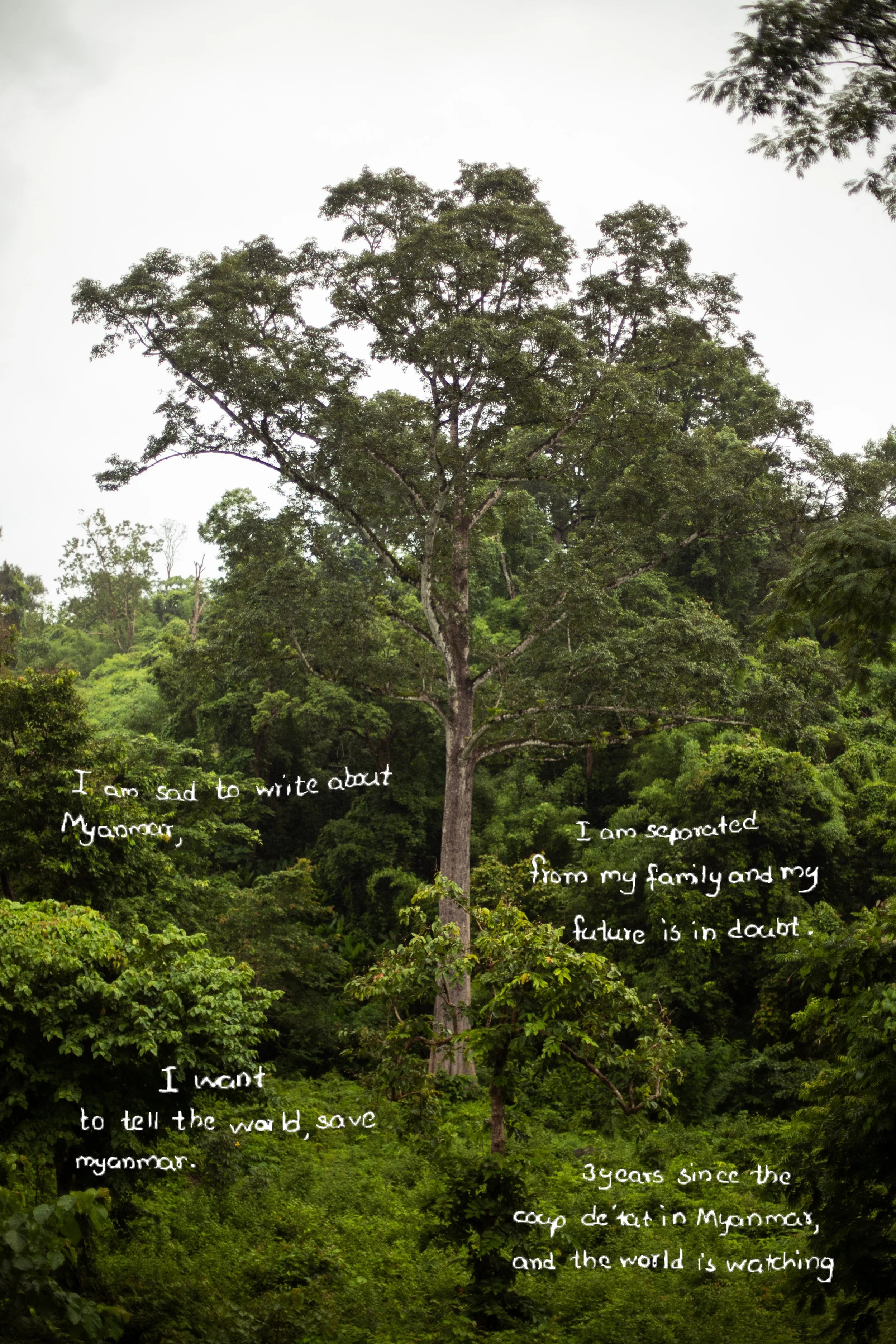
Students walk the grounds of Noh Bo Academy, located near the Myanmar border. The school provides education for children displaced by conflict. Text written by a student at Noh Bo Academy: “I feel deeply sad. All our dreams have been lost. I wish the children in the country’s IDP camps could study peacefully and properly. Instead of just feeling sad like us, they live in constant fear. My heart aches every time I think about my country, Myanmar.”


At the end of the school day, a young girl at White School in Mae Sot carefully packs away her pencils. The school was founded by its principal, herself a refugee, after she saw the urgent need for formal education among migrant families fleeing the conflict in Myanmar. Today, White School teaches children from Kindergarten to Grade 9 (GSCE level). Text written by a teacher at White School: “Because of Myanmar political situation many people face difficulties and many problems. Since military coup some states cut off the electric and the whole country cut off the Internet. So Myanmar people face the difficulties. Please help my country.”

Young girls from Sunshine School sit outside their classroom, laughing together during break-time.

Sunshine School sits on the edge of the Thai-Myanmar border, with the mountains of Myanmar visible in the distance. Its location has made it a crucial refuge for children fleeing escalating violence in Karen State. Every day, new families arrive, hoping to secure a place for their children. Founded in Karen State, Sunshine School was destroyed in 2009 when the Myanmar army burned it down during a period of heightened conflict. The school’s founders rebuilt in Mae Sot, where it now serves both local and cross-border students. Text written by a student at Sunshine School: “I feel sad. The certain future we once had is gone. My country may not survive much longer — it could fall under the control of others.”


Mae-La refugee camp, one of the largest in Southeast Asia, is home to an estimated 30,000 to 40,000 people. Located near Mae Sot on the Thai-Myanmar border, the camp has seen a sharp rise in arrivals since Myanmar’s 2021 military coup, as escalating violence forced thousands to flee. Refugees are confined to the camp under Thai military supervision and face fines if caught outside its boundaries. Text written by a student at KKB School: “Myanmar has faced military coup. Some students cannot attend school. A lot of citizens have no home. Some families don’t meet anymore with their family.”

Sixteen-year-old Nan Yadanar San (bottom right) poses with her football team on the grounds of KKB School, where they live and study. She fled Myanmar alone after fighting reached her village in Karen State, leaving the care of her grandmother to continue her education in Mae Sot. Today, her team competes in local football tournaments alongside Thai and migrant students.

As evening falls, two boys sit at the edge of the soccer field at KKB School, watching the last light fade across the grounds. For many displaced children here, moments of rest are rare. Text written by a student: “Now Myanmar citizens are facing a military coup. All the young people are losing their life and they are also fighting against this coup. Because of the civil war, both education and food are difficult.”


A view of the Mae Sot countryside on a road coming from the north towards Mae Sot city centre. Thailand and Myanmar share a land border of nearly 2,500 kilometres with a similar geographical landscape. (Text) A student writes: “I’m feeling deeply unhappy every moment. The younger generation is losing their future because of political turmoil, and many people are lost, not knowing what to do. Some are far from home and family, forced to flee due to the unrest. It breaks my heart to be away from my country, living in another place filled with challenges and hardships. This is the weight of what I’m feeling.”

Nan Hser Tha Mote, 28, leads children through a dance rehearsal for the school’s summer camp talent show. A refugee from Karen State, she arrived in Mae Sot in 2015 and began studying at a migrant school. After completing high school, she trained as a teacher and now works with displaced children, helping them rebuild their futures.

Text written by a student at Thoo Mweh Khee school: “The people in Myanmar try hard to save their life, build good future for our people. Save our country.” Two students walk down the corridor of the outdoor classes at Thoo Mweh Khee school which is one of the largest schools in the Mae Sot area providing education and boarding for refugees. Puedo, the principle of the school and a refugee himself said that even though they are overwhelmed with the increase of students in recent years, that “everyone is accepted. They arrived for a good reason so we have to accept them.”

Teachers, students, and local villagers gather to watch a summer sports tournament at Maw Kwee School. Located in a rural area near Tha Song Yang, close to the Thai-Myanmar border, the school has become a central hub for the surrounding community of migrants and refugees.

A large tree located on the border with Thailand and Mae Sot. Text written by a migrant teacher from KKB School: “I am sad to write about Myanmar. I am separated from my family and my future is in doubt. I want to tell the world ‘save Myanmar’. 3 years since the coup d’etat in Myanmar and the world is watching.”
Mindscapes of Mae Sot (2024)
The conflict in Myanmar has displaced more than three million civilians, according to the United Nations. For nearly 4 decades, children have fled the country’s political instability and violence in search of safety and education in neighbouring Thailand. In Mae Sot, just across the Thai-Myanmar border, refugee-led schools and NGO-supported learning centres have become sanctuaries where displaced children can learn, play, and rebuild a sense of normality.
I travelled to Mae Sot last year while on assignment for the NGO Givology to document life inside these schools. As a visual journalist, I was struck by a challenging contradiction: while hearing stories of trauma, displacement, and loss, I was photographing scenes of playful, resilient children and tight-knit, hopeful communities. These schools are places of relative safety, but the memories of conflict remain just beneath the surface.
To reflect this dual reality, I invited teachers and students to handwrite their thoughts, memories, and hopes directly onto images of the schools and landscapes. Their testimonies — intimate and unfiltered — transform the photographs into a layered narrative of trauma and survival.
This photo essay is narrated through the voices of students and teachers themselves. The images, paired with their handwritten reflections, invite us into the inner worlds of children and educators and the reality of experiencing forced displacement.